Vol. 2, Issue 6 - Nov /Dec 2006
Posted: Saturday 25th November 2006
As a natural development from producing Lightweight News, Patricia and I have built a website – ‘Classic Lightweights UK’. The URL is www.classiclightweights.co.uk . We are adding more pages to the site every week so even if you have looked recently there may well be something new to interest you. The idea is to accumulate as much information as possible on classic UK bikes plus classic Italian ones too and to make it available to a wider audience. We hope that the site will aid those who are planning to build classic bikes with sympathetic accessories as we often get enquiries about this from readers in both the UK and the USA. There have been dozens of messages of congratulations from all around the world so we are well pleased with the response. A few Marque Enthusiasts and others with specialised knowledge have contributed items, as you can see.
Things have levelled out a bit now but for weeks we were having to do most of the research for pages as well as constructing the site. The upside of this is that we are learning a great deal about marques previously unfamiliar to us. If you feel any page is lacking in depth please forward extra copy to us, GB and Reynolds come to mind. We do have promises of material for four more classic frame builders, Rotrax, Mercian, Joe Cooke and special products division of Raleigh and will upload them as soon as they are received. Two more readers are working on copy for us. Three Marque Enthusiasts who have entered into the spirit of things have received valuable information from non-members of the V-CC which has given them some very important information. We have been amazed at the amount of interest from owners of real classics, sometimes even with a collection of same, who are not members of the V-CC but are eager for a vehicle to pass on help and information.
From Steve Griffiths: ‘Re Alec Singer’s shop in Paris it’s bus 53 from Gare St Lazare’ – so no excuse to miss it now!
How many spotted the deliberate mistake in the last issue stating that Coppi won the Tour de France using a Paris/Roubaix gear? Bryan Clarke did and says: Coppi won the 1949 TdeF riding Simplex gears sponsored by Lucien Juy. However, he returned in 1950 and won the Paris-Roubaix from which the gear was named. In 1951 he was riding a prototype of the Gran Sport gear and can be seen alongside Bartali riding Cervino gears for which he had a stake in the company. Photo on front cover of the Dancing Chain.
Just after WW II (1945+) virtually every serious cyclist rode his machine with fixed-wheel rather than gears. The exceptions were some serious tourists, who would take their bikes abroad to places like Switzerland whilst in the UK many tourists doggedly stuck to fixed even though they were touring in the hilliest areas whilst laden with luggage and camping gear for two weeks awheel (probably a spare pair of pants, an ex-army bivouac tent – if lucky – a tin of corned beef and a primus).
A study of racing cyclist pictures of this era will show that fixed was used for every time-trial from the shortest (usually 25 miles in those days) to the 24-hour events where the riders would clock up over 400 miles. I still ride fixed from time to time but find that after 40+ miles I am really ready for a rest – imagine this ten times over. There is something about riding fixed which gives one a slightly smug feeling, usually detected via a self-satisfied grin or even dare I say a smirk from some of us. Cambridge Section run a lightweight event on May 27 over a flat course ideally suited to riding fixed-wheel in comfort, so start oiling and polishing that bike you never quite get round to using.
It must be said that at this time of fixed-wheel fixation there was a rebel gang known as the League (wash your mouth out with carbolic and go straight to bed!) whose riders started with 3-speed derailleurs and soon to four, five and blow me, even 10 gears. If you were in the Union, even to mention the word League could result in ending up in front of a wall, blindfolded and taking your last puff on a Woodbine. I think I have already said that I was brought up in a strictly Union area but secretly hankered for the devil-may-care attitude of the Leaguers. A friend and I used to cycle over a hundred miles to go out on a League (Stonebridge Wheelers) club run near Coventry and then cycle home again to King’s Lynn.
Eventually (say 1953ish) cracks began to show amongst the fixed-wheel brigade as they experimented with gears. The Cycling Weekly letters page was full of vitriolic letters denouncing this ungentlemanly and un-British behaviour as akin to treachery. As everyone had been using fixed up to this period, many machines were built up on road/path frames which were built to track specification complete with track ends.
I even have one, an Ephgrave, with track ends and pump pegs brazed under the top tube whilst most of them had at least mudguard eyes and clearance. As they were built for fixed, most rear ends were not much more than 100mm (4” in old money) across. Luckily, at this time, most gears were 3 x 1/8 or for the lucky few who could get hold of Continental equipment 4 x 3/32 and it was possible, with a bit of springing, to get these hubs into the frame. As I said, many riders had frames with track-ends and by a stroke of luck these were ideal for the Osgear set-up. With Osgear the secret in setting them up was to get the striking fork as close to the large sprocket as you could.
If this was done in normal forward drop-outs it was quite a problem to get the wheel out as the sprockets jammed up against the striker arms, especially if, in the panic, you hadn’t jumped onto the smallest cog. With a track machine the wheel left the rear of the frame in an orderly and gentlemanly way as hopefully (small cog again) there was enough slack in the chain to allow this and the tension arm was more conducive to this than a double-pulley changer would have been. A natural development of all this was of course the Stallard Osgear rear ends which had a normal forward facing slot plus, in front of it, a rear facing one for use with the Osgear. There was also a guiding prong to keep the sprockets away from the striker. The forward facing slot was there so the rider could revert to fixed – probably for winter training on snow and ice – men were real men in those days.
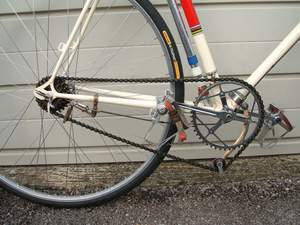
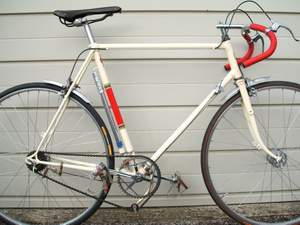
A few gear manufacturers produced their gears with the option of a rear-facing hanger which made life easier in the event of a puncture on a machine with rear facing track ends. They still turn up from time to time. Builders of modern bikes make no concessions to the concept of fixed-wheel (and why would they?). They are able to have vertical rear drop-outs making the wheel absolutely secure in the frame and no chance of it pulling forward. An additional bonus is that it is possible to have a very compact rear triangle with the tyre nearly touching the back of the seat tube.
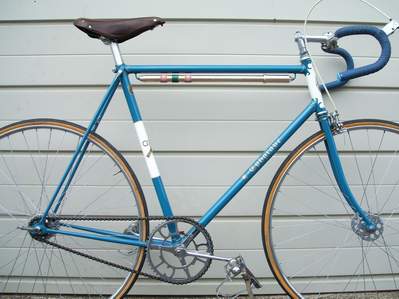
On the other side of the wall (the Union), the archetypal time-trial machine of the period (for the well off) was a road/path frame with Chater cranks and pedals, Brooks Swallow saddle, Conloy rims – either HPs or sprints – on Harden hubs. The Ephgrave below is such an example with mudguard eyes in the fork ends and even pump pegs under the top tube.
Union boys loved, on the whole, to have the curliest most fancy lugs they could afford whereas the Leaguers and road racers went for the simpler classic ‘Italian’ style lugs along with brighter coloured frames.
“I am trying to trace the builder of an interesting frame that I have acquired. I was told it was a grass track racing bike and it has some cut-outs on the inside of the chainstays to accommodate larger tubs. It also has a similar filed out area with an elliptical plate added on the outside of one stay to give chainring clearance. It has stickers on the frame saying ‘Beadle Pro England’. It has the frame number 7452 on the left-hand track end.”
“I bought it off a chap whose brother had owned it from new, who also had a Hetchins road frame. It was suggested it may be a Bates or a Dave Davis / Davies? as it was from that part of London but I have not been able to confirm this. I have followed various leads suggesting it might be a Holdsworth or Condor, but have managed to confirm it is not. Any thoughts re the frame builder or ‘Beadle pro’ from you or other readers of Lightweight News would be much appreciated.”
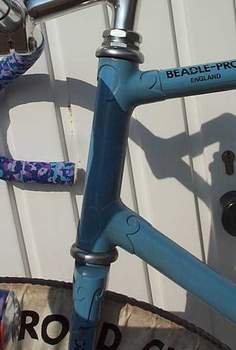
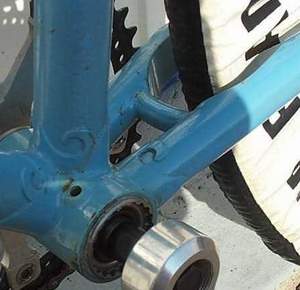
V-CC member Stephen Harvey (Ex Bon Amis CC, 1961-64).tells me that he bought two machines in 1961, a Holdsworth Monsoon and his wife’s Carlton Courette. Both were bought as whole machines from Len Buttrey in Reading in 1961. [Len was a classic lightweight dealer and well-known RTTC timekeeper, often in Pangbourne Lane. He must have held the watch for many comp records, perhaps even for Booty’s sub-four-hour 100.] Stephen’s love is Rotrax and he hopes to create a photo-record of as many as he can.
Gordon Barnes was another whose memories were jolted by the piece on ‘Gen’ and ‘Ungen’ and says. “Ever since reading the article on Johnny Mapplebeck I’ve been meaning to say how much I enjoyed it. Being a “Leeds Lad” in the 1950`s we were generally loyal to JRJ Cycles – which eventually separated into Bob Jackson’s & Woodrup Cycles when the two partners at JRJ went their separate ways – but if you were a “Bradford Lad” you were loyal to either Ellis Briggs or Johnny Mapplebeck. There has always been a great rivalry between Bradford & Leeds as they are geographically so close together – in all things sporting & commercial – not just in your choice of bikes! Although I loved my first proper racing bike (a JRJ) it was obvious that Pennine Cycles produced some super bikes and Johnny himself was a great character.
Gordon goes on: “As a lad I delivered orders for Gallons Grocers after school to save up for my first proper road racing bike – a JRJ built to my own spec in ice blue with 72 degrees parallel angles 23 inch down tube & top tube – I sold it very reluctantly many years later. The frame cost me £15 in 1958 and I remember walking the 5 miles home with it over my shoulder as I thought I might scratch it if I took the bus!
On the subject of what was “gen” – as a BLRC member I had a cape roll under the saddle with tools, etc wrapped inside – but the fashion in 1958/59 was to use a plastic cover to stop the toe strap you used to hold it in place cutting into your cape – the “fashion” was to pinch one of the advertising banners that used to be hung outside sweet shops – usually advertising Walls Ice Cream – they were about a foot square and the perfect size! It was also “gen” to have a Brooks B17 Champion Flyer saddle with copper rivets and Mafac Centre Pull brakes but you had to use Weinmann levers with them. If you could get hold of an “Evian” drinking bottle as used on the continent you were really “gen”!
Stephen Harvey also had his piece on ‘Gen’ – I think the response shows just how fashion conscious the racing cyclist was in the 40s and 50s. He says: “On the subject of ‘gen’ and at the risk of duplicating something that’s already been covered but which I have not yet read, has anyone reminded readers of that 1950s phrase, said of an inexperienced and unfit rider: “He’s just a tuggo with the bonk”? As a matter of interest, I have a copy of the very first issue of Jock Wadley’s magazine, initially called simply ‘Coureur’, with a yellow and black cover. I bought it from Jim Guard’s shop in Southampton in 1955. I also bought my first Rotrax in the autumn of that year, a ‘Shirley’, fitted with a Gnutti steel cotterless at my request.” (Frames were usually sold complete with chainset in the 50s – Ed)
The term ‘Tuggo’ was used to indicate anyone who didn’t fit in the cycling scene at the time. The Tuggo probably had a bike bought from a mass-producer of sports cycles with gears, mudguards, etc. It is hard to imagine the contempt which went behind that word – it was dog eat dog in those days.
Ankle socks (or no socks) were a great indicator of whether you were ‘Gen’ or not. Even the National bodies spent hours discussing the rights and wrongs of ankle socks and one well known rider had a record ride disallowed as he wearing the wrong ones!! In a period when cycling was split assunder by the intransigence of the leaders of the ‘Union’, at a meeting where they were supposed to be trying to come to a compromise position for the benefit of every cyclist in the UK they spent the greatest part of the meeting discussing ankle socks.
I think everyone knows the meaning of ‘Bonk’ or ‘Hunger Knock’. A Northerner riding recently with the Cambridge CC was heard to say, “this is the only club where I have heard ‘The Bonk’ known as Glycogen Deficiency.” Goodness knows what he thought when the chat over the coffee break was on genetic structures and the Genome map plus a discussion on advanced computer programming.
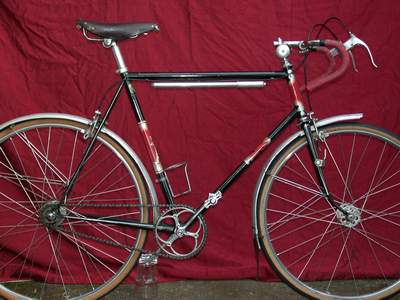
Although Patricia and I also ride top specification modern bikes and follow international racing, etc (we are going to the Munich 6-day Cycle Race on November10/11) I always find modern cycling publications very boring and hardly ever get to the end of an article. However if I ever come across writing by J. B. (Jock) Wadley, who wrote in the 50s and 60s I can read him from start to finish. Mal Rees who gave up frame manufacture to become a writer on the sport is another whose copy I can absorb without any problem.
THE LIGHTWEIGHT GROUP 2007 CALENDAR OF SPECIAL EVENTS
The Lightweight Group is a ‘Special Interest Group’ within the V-CC
The Dorset Lightweight Ride
Sunday April 15th From Bovington (nr. Wareham)
A relaxed, thirty-mile, jaunt in the quite lanes of Thomas Hardy country.
For pre-1960, period-equipped lightweight cycles only.
Organizer: Neil Foddering 01305 816001
The Somerset Lightweight Weekend
Incorporating the 2nd Lightweight Group Annual Dinner
Saturday June 30th and Sunday July 1st From Langport (nr. Yeovil)
A glimpse of life awheel as it used to be. Two very sociable and atmospheric days of old club cycling on old club cycles. Local accommodation available.
For pre-1960, period-equipped lightweight cycles only.
Organizers: Alexander and Sharron von Tutschek 01225 465532
The Oxfordshire Lightweight Ride
Sunday August 12th From Frilford (nr. Abingdon)
A flattish ride, of about thirty-five miles, in the beautiful Vale of the White Horse. The route is well suited to single-geared machines.
For pre-1960, period-equipped lightweight cycles only.
The Berkshire Lightweight Ride
Sunday September 16th From Theale (nr. Reading)
Forty-or-so miles on the quiet, time-forgotten lanes around the Thames Valley.
For pre-1960, period-equipped lightweight cycles only.
Lightweight Group event organizers prefer and encourage sympathetic attire. Modest and understated clothing will therefore be greatly appreciated. However, this is not compulsory.
Posted: Saturday 25th November 2006
This article appears in the following categories.
Upcoming Events
Whether you are looking for a gentle social meet up, or a 100-mile ride browse the community’s upcoming events and plan your next weekend outing.
